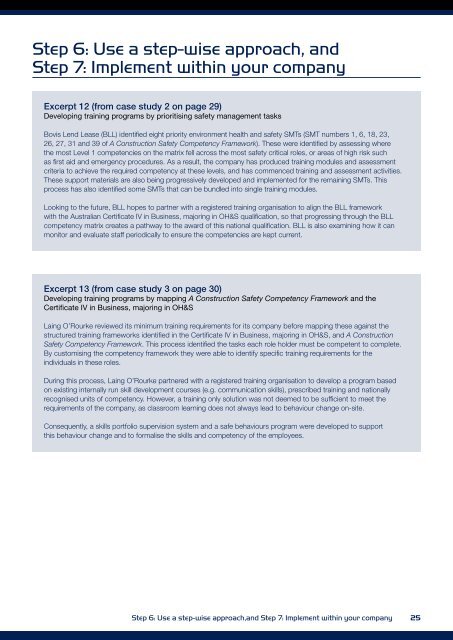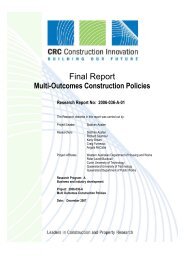A Practical Guide to Safety Leadership Book (PDF 5MB) - QUT ePrints
A Practical Guide to Safety Leadership Book (PDF 5MB) - QUT ePrints
A Practical Guide to Safety Leadership Book (PDF 5MB) - QUT ePrints
Create successful ePaper yourself
Turn your PDF publications into a flip-book with our unique Google optimized e-Paper software.
Step 6: Use a step-wise approach, and<br />
Step 7: Implement within your company<br />
Excerpt 12 (from case study 2 on page 29)<br />
Developing training programs by prioritising safety management tasks<br />
Bovis Lend Lease (BLL) identified eight priority environment health and safety SMTs (SMT numbers 1, 6, 18, 23,<br />
26, 27, 31 and 39 of A Construction <strong>Safety</strong> Competency Framework). These were identified by assessing where<br />
the most Level 1 competencies on the matrix fell across the most safety critical roles, or areas of high risk such<br />
as first aid and emergency procedures. As a result, the company has produced training modules and assessment<br />
criteria <strong>to</strong> achieve the required competency at these levels, and has commenced training and assessment activities.<br />
These support materials are also being progressively developed and implemented for the remaining SMTs. This<br />
process has also identified some SMTs that can be bundled in<strong>to</strong> single training modules.<br />
Looking <strong>to</strong> the future, BLL hopes <strong>to</strong> partner with a registered training organisation <strong>to</strong> align the BLL framework<br />
with the Australian Certificate IV in Business, majoring in OH&S qualification, so that progressing through the BLL<br />
competency matrix creates a pathway <strong>to</strong> the award of this national qualification. BLL is also examining how it can<br />
moni<strong>to</strong>r and evaluate staff periodically <strong>to</strong> ensure the competencies are kept current.<br />
Excerpt 13 (from case study 3 on page 30)<br />
Developing training programs by mapping A Construction <strong>Safety</strong> Competency Framework and the<br />
Certificate IV in Business, majoring in OH&S<br />
Laing O’Rourke reviewed its minimum training requirements for its company before mapping these against the<br />
structured training frameworks identified in the Certificate IV in Business, majoring in OH&S, and A Construction<br />
<strong>Safety</strong> Competency Framework. This process identified the tasks each role holder must be competent <strong>to</strong> complete.<br />
By cus<strong>to</strong>mising the competency framework they were able <strong>to</strong> identify specific training requirements for the<br />
individuals in these roles.<br />
During this process, Laing O’Rourke partnered with a registered training organisation <strong>to</strong> develop a program based<br />
on existing internally run skill development courses (e.g. communication skills), prescribed training and nationally<br />
recognised units of competency. However, a training only solution was not deemed <strong>to</strong> be sufficient <strong>to</strong> meet the<br />
requirements of the company, as classroom learning does not always lead <strong>to</strong> behaviour change on-site.<br />
Consequently, a skills portfolio supervision system and a safe behaviours program were developed <strong>to</strong> support<br />
this behaviour change and <strong>to</strong> formalise the skills and competency of the employees.<br />
Step 6: Use a step-wise approach,and Step 7: Implement within your company 25

















